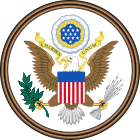Slave Trade Act of 1794 facts for kids
 |
|
| Long title | An Act to prohibit the carrying on the Slave Trade from the United States to any foreign place or country |
|---|---|
| Enacted by | the 3rd United States Congress |
| Effective | March 22, 1794 |
| Citations | |
| Public law | Pub.L. 3-11 |
| Statutes at Large | 1 Stat. 347 |
| Legislative history | |
|
|
| Major amendments | |
| Slave Trade Act of 1800 | |
The Slave Trade Act of 1794 was an important law passed by the United States Congress. It stopped American ships from taking part in the international slave trade. This means they could no longer carry enslaved people from one country to another.
President George Washington signed this law on March 22, 1794. It was the first of several laws passed by Congress to stop the slave trade. Later, in 1800, Congress made the law even stronger. They increased the fines for breaking it. They also gave rewards to people who reported illegal slave trading.
In 1807, the United States made it illegal to bring new enslaved people into the country. Finally, in 1865, the Thirteenth Amendment to the United States Constitution made owning slaves illegal everywhere in the U.S.
How the Law Was Passed
This law was first suggested during the 3rd Congress. This meeting of Congress started on December 2, 1793. The bill was then passed on March 22, 1794. Its full name was "An Act to prohibit the carrying on the Slave Trade from the United States to any foreign place or country."
What the Law Said
The Slave Trade Act of 1794 made it illegal for anyone in the United States to be involved in the international slave trade. This included American citizens and foreigners living in the U.S.
Here's what the law mainly said:
- No one could build, prepare, or load a ship in the U.S. for the purpose of trading slaves in other countries.
- No ship could sail from a U.S. port to buy or sell enslaved people in foreign lands.
- If a ship was prepared or sailed for these reasons, the ship and everything on it could be taken by the U.S. government.
- Ship owners who broke the law could also face a large fine of $2,000.
- The law also affected foreign merchants.
- Any enslaved people found on a ship breaking the law would be taken. The ship owner would also be fined $200 for each enslaved person.
In simple terms, the law stopped American ships from being part of the international slave trade. It also required foreign ships using U.S. ports to agree not to export enslaved people from those ports.
The First Case Under the Law
In 1795, a merchant from Providence, Rhode Island, named John Brown, planned to trade in slaves. He worked with a ship captain named Peleg Wood. They planned to use a ship called Hope for this trade.
By November 1795, the Hope was involved in the slave trade. In March 1796, Rhode Island fined the ship's owners £200. This was because slave trading was already illegal in that state.
Later in 1796, Brown's ship sailed to Africa. It then returned to Havana, Cuba with 229 enslaved people on board. This trip led to John Brown being put on trial in 1796. He was accused of breaking the new Slave Trade Act of 1794.
John Brown became the first American to be tried in a federal court under this new law. On October 5, 1797, Brown lost his case. His ship was taken by the government, as the law stated.

